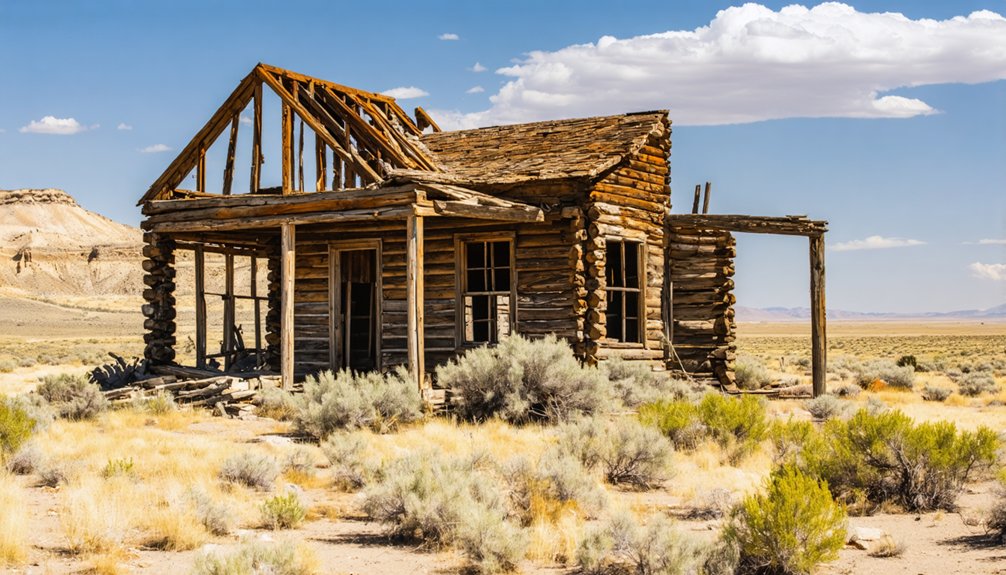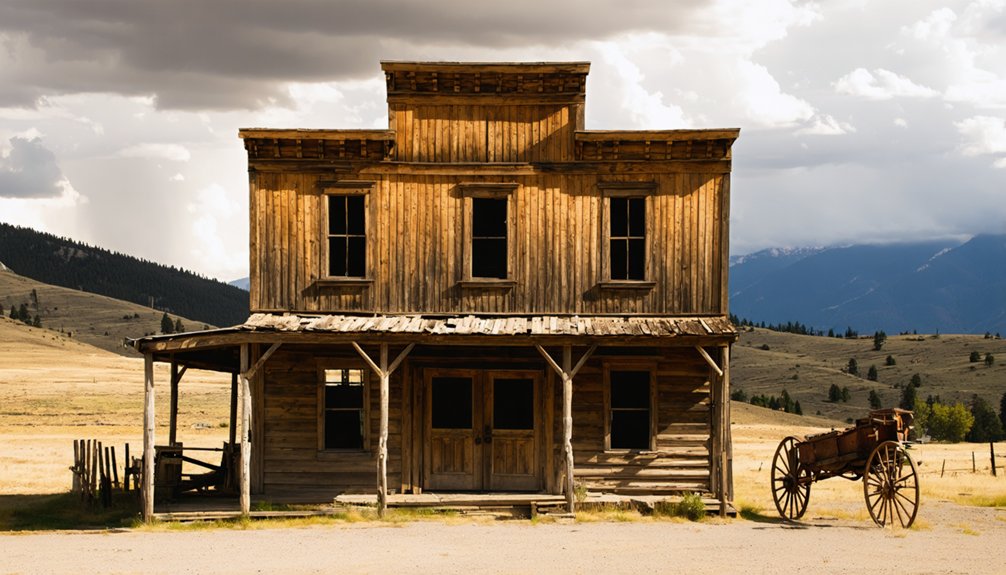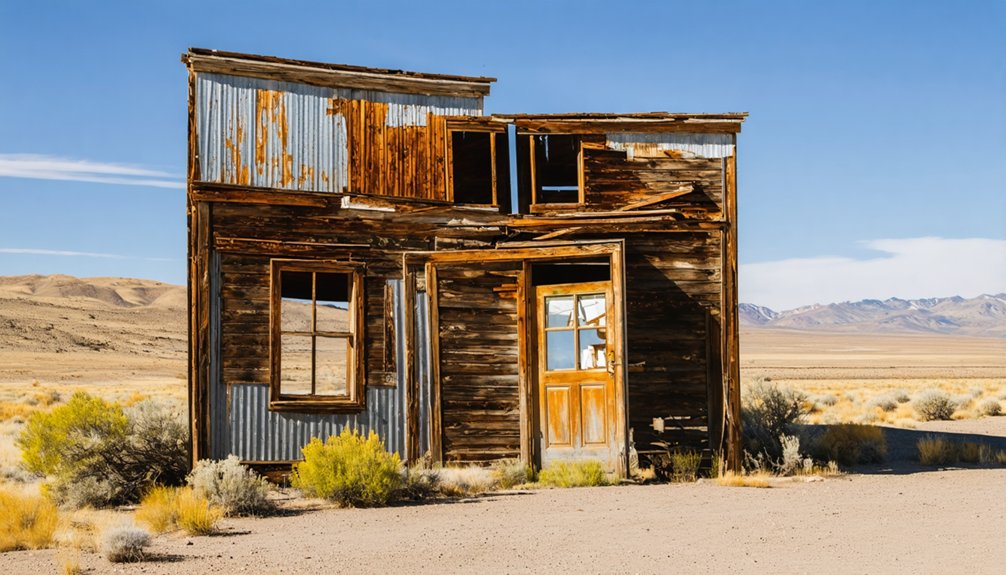You’ll find Rockville Stage Stop‘s remains about an hour northeast of Boise, where a distinctive boulder formation marked this essential waypoint between Boise Valley and the Owyhee Mountain silver mines in the 1870s. Originally called “The Rocks,” this frontier hub provided critical services for miners, stagecoaches, and mail carriers until the 1960s when fire claimed its structures. Today, weathered foundations, a brick schoolhouse shell, and Mrs. Ed Holmes’ solitary grave reveal a deeper frontier story waiting to be discovered.
Key Takeaways
- Rockville Stage Stop was a vital 1870s transportation hub between Boise Valley and Silver City, serving miners with lodging and supplies.
- The site, originally named after a prominent boulder landmark, was crucial for stagecoach operations, freight services, and mail delivery.
- Only scattered foundations and a brick schoolhouse shell remain today, as the original structures were destroyed by fire in 1960s.
- The ghost town is accessible via McBride Creek Road, requiring high-clearance vehicles and emergency supplies due to remote location.
- Historical violence, including Native American conflicts and gunfights, marked the site’s frontier period, with Mrs. Ed Holmes’ 1889 grave still visible.
Origins of the Stage Stop’s Name
The rugged boulder that gave Rockville its name marked one of southern Idaho’s most recognizable stagecoach landmarks in the 1870s.
You’ll find that freight wagons regularly used this distinctive rock formation as a strategic stopping point, where drivers could safely store feed above ground away from prowling coyotes.
The name evolution reflects the site’s geographic significance, starting as “The Rocks” before transforming into “Rockville” as permanent structures emerged around the boulder.
From humble geological beginnings as The Rocks, this settlement naturally evolved into Rockville alongside the growth of its frontier community.
When settlers established a proper community with a post office in 1885, they formalized the name to match other frontier towns of the era.
You can trace this naming pattern throughout southern Idaho, where natural landmarks often inspired community identities during the region’s development.
The area was previously known as Bug Town, which later became the town of Caldwell.
A bustling 19-room hotel built in 1903 became a centerpiece of local activity, featuring sleeping quarters and a popular dance hall.
A Critical Hub on the Mining Route
You’ll find Rockville’s vital role as a transport hub reflected in its strategic position along the mining route to the Owyhee Mountains.
Your journey through this frontier outpost would’ve included access to essential services like lodging, meals, and supplies needed for the arduous trek to the mining camps.
The stage stop’s importance to the regional economy centered on its ability to connect major towns like Boise and Mountain Home with the mining districts, making it an indispensable link in Idaho’s late 19th-century transportation network. Similar to Wood River’s development, stages and freight wagons were crucial for reaching areas where railroads couldn’t access.
Transport Network Hub Essentials
Positioned strategically along the significant overland trail connecting Boise Valley to Silver City’s mining districts, Rockville Stage Stop emerged as an indispensable transportation hub in late 19th century Idaho.
The journey typically took about two weeks from surrounding major settlements to reach the bustling mining regions via the stage stop network.
You’d find this essential nexus of transport logistics managing triweekly stagecoach operations, freight operations, and mail services that kept the mining regions connected and supplied.
The stop’s clever use of elevated rock surfaces for protecting supplies from wildlife made it a preferred choice for weary travelers and freighters alike.
- Feel the rush of freedom as stagecoaches thunder past The Rocks, carrying dreams of silver and gold
- Experience the bustle of freight wagons loading precious cargo for remote mining camps
- Imagine the relief of tired miners finding refuge after long days on dusty trails
- Witness the determination of wool growers and ranchers supplying the mining corridor
- Marvel at the ingenuity of early pioneers protecting essential supplies on elevated rocks
Frontier Life and Supplies
Life at Rockville Stage Stop revolved around three essential frontier needs: shelter, sustenance, and supplies. You’d find durable structures built to withstand the rocky terrain, offering refuge to weary miners and freight workers traversing the route to Silver City.
The stop’s strategic position helped minimize supply shortages by storing critical provisions like animal feed on boulder tops to thwart wildlife theft.
Community interactions flourished as the site evolved beyond mere logistics. You’d witness travelers exchanging news while restocking wagon parts, miners sharing tales over meals, and freight workers conducting business at the post office.
The stop’s innovative storage solutions and essential services – from equipment repairs to food preparation – kept the mining operations flowing through seasonal challenges and economic uncertainties.
Life at the Frontier Waypoint
You’d find life at Rockville Stage Stop defined by constant vigilance against Indian raids and the nightly task of securing supplies on the landmark boulder to protect them from wildlife.
Today, visitors camp in primitive dispersed sites while exploring this historic location. As a traveler, you’d rely on Mrs. Ed Holmes and other station operators to provide hot meals, fresh horses, and a safe place to rest before continuing your journey through the rugged Owyhee terrain. This essential way station stood until the early 1960s, when fire claimed the original structure.
Your survival in this harsh frontier outpost depended on the tight-knit community of wool growers, ranchers, and station workers who maintained this essential link in the region’s transportation network.
Daily Frontier Challenges
Standing guard against the harsh Owyhee County terrain, Rockville Stage Stop tested the resilience of frontier dwellers with daily challenges that would break lesser spirits.
Your daily routines meant constant vigilance, from hauling water before sunrise to securing provisions atop boulders at nightfall. Much like the struggles faced at Bayhorse’s stone buildings, the stop’s inhabitants had to maintain their vital structures against the elements. The buildings’ durability came from their lava rock walls, providing critical shelter in this unforgiving land. Survival strategies evolved with each season’s unique threats – scorching summers, brutal winters, and unpredictable wildlife.
- You’d wake to frozen water buckets in winter, with miles of snow between you and the nearest help.
- Your muscles would ache from endless building repairs and wagon maintenance.
- You’d strain your eyes scanning the horizon for raiders while tending livestock.
- Your nights meant staying alert despite exhaustion, ready to defend against bandits.
- Your precious supplies could vanish in an instant to coyotes or floods.
Pioneer Support Network
Through the bustling decades of the 1870s to 1920s, Rockville Stage Stop wove together an essential network of pioneer support that stretched far beyond its humble foundations.
You’d find a 19-room hotel, stables, and dance hall serving as the backbone of pioneer logistics between Boise Valley and Silver City.
As you traveled the frontier, Rockville’s role in community support proved invaluable. The post office kept you connected to the outside world, while the site’s precinct status helped maintain civic order through voting and census activities.
You could count on hot meals, secure overnight shelter, and feed for your animals. Local ranchers and wool growers pitched in, creating a web of mutual aid that strengthened frontier survival, while the hotel’s social gatherings helped ward off the isolation of pioneer life.
Notable Historical Events
Life at Rockville Stage Stop was marked by episodes of violence that reflected the broader tensions of frontier Idaho. You’ll find evidence of violent altercations throughout its history, from Native American attacks to deadly gunfights. Similar tensions were seen across Owyhee County territory, where hostile tribes initially inhabited the unexplored land before miners arrived.
The most tragic incident occurred in 1889 when Native Americans killed Mrs. Ed Holmes, wife of the stage stop operator. Cultural tensions reached a boiling point in 1868 when Sam Lockhart and Marion More’s dispute ended in bloodshed at a nearby hotel.
- Mrs. Holmes’s lonely grave marker stands as a silent witness to frontier violence
- The shooting between Lockhart and More left both men dead – More immediately, Lockhart from infection
- Native American raids highlighted the clash between settlers and indigenous peoples
- The stage stop’s remote location made it vulnerable to conflict
- Despite arrests following the 1868 shootings, justice remained elusive in the frontier setting
Structural Remains Today

Today, only scattered foundations mark where the once-bustling Rockville Stage Stop served travelers along Idaho’s frontier trails.
You’ll find these remnants near a creek bed, accessible via McBride Creek Road, where vandals destroyed the original structures by fire in the 1960s. The site’s structural integrity has diminished over time, though you can still trace the layout of the settlement through its remaining foundation stones. Similar to the Star Valley airstrip, this location’s remote nature presents unique challenges for visitors.
Nearby, you’ll discover a two-story brick shell of an old schoolhouse, standing as a silent emblem of the area’s later development.
While preservation efforts remain minimal, the remote location in Owyhee County has helped protect what’s left.
You’ll also spot scattered metal artifacts and the occasional grave marker, including one for Mrs. Ed Holmes from 1889, adding depth to this frontier ghost town‘s story.
Getting There: Travel Tips
While reaching Rockville Stage Stop requires careful planning, you’ll find the site about an hour northeast of Boise via rural and unpaved roads.
Road conditions demand a high-clearance vehicle, and you’ll want to pack emergency supplies given the remote location. The dispersed camping area welcomes larger rigs, but the journey there tests your pioneering spirit through untamed terrain.
- Pack extra fuel, water, and supplies – there aren’t any services near the ghost town
- Check weather forecasts closely, as seasonal conditions can make roads impassable
- Bring physical maps and GPS coordinates since cell service is nonexistent
- Plan your visit during spring or fall for the most favorable road conditions
- Contact the local BLM office about current permit requirements and restrictions
The site’s isolation preserves its authentic character, rewarding those willing to venture off the beaten path.
Historical Legacy and Significance

Nestled among the rugged Owyhee terrain, Rockville Stage Stop emerged in the 1870s as an essential lifeline between Boise Valley and the bustling mining camps of Silver City.
You’ll find its cultural impact woven into the fabric of Idaho’s frontier spirit, where a single boulder marked the beginning of a crucial transportation hub.
The stage stop’s economic transformation mirrors the American West’s evolution. What started as a simple supply cache grew into a 19-room hotel with a dance hall, becoming the heart of regional commerce and social life.
Though Rockville’s glory faded when automobile routes bypassed it in 1928, you can still trace the town’s significance in the remaining ghost town ruins, which stand as evidence to the dynamic shifts in Western transportation and commerce.
Exploring the Ghost Town Site
Located just 2.5 miles off Highway 95 from Marsing towards Jordan Valley, Rockville Stage Stop beckons modern-day explorers with its haunting remnants.
You’ll find the ghost town exploration accessible via 2WD roads, though winter visits might challenge your vehicle with muddy terrain.
While vandals destroyed most structures in the 1960s, the site still holds fascinating historical artifacts and stories waiting to be discovered.
- Stand among the weathered foundation stones where weary travelers once sought refuge
- Discover Mrs. Ed Holmes’ solitary grave from 1889, a reflection of frontier life
- Search the grounds with your metal detector for hidden treasures of the past
- Wander among the massive boulders that guided freighters along their journey
- Experience the raw beauty of Owyhee County’s untamed landscape, much as the pioneers did
Frequently Asked Questions
Are There Any Documented Paranormal Activities or Ghost Sightings at the Site?
You’ll find documented ghost encounters at this historic outpost, where your smartphone might catch spectral sightings of Mrs. Stricker’s spirit near dusk, plus shadowy figures lurking around the old traveler’s cemetery.
What Native American Tribes Were Involved in the Conflicts Around Rockville?
You’ll find the Western Shoshone and Bannock tribes were primary groups involved in regional conflicts, with both participating in territorial disputes and defending their ancestral lands against settler encroachment.
How Much Did Stagecoach Passengers Typically Pay to Stay Overnight?
You’d pay between 25 cents to $1.00 for overnight accommodations at stagecoach stops – that’s equivalent to $7-$30 today. Your fee often included a shared room and hot meal.
Were Any Valuable Artifacts or Treasures Ever Discovered at Rockville?
You won’t find treasure hunting success at this location. Archaeological digs revealed ancient stone tools and Native American artifacts, but no precious valuables. Local artifact preservation focuses on cultural significance rather than monetary worth.
Did Any Famous Historical Figures Pass Through the Rockville Stage Stop?
Plainly put, you won’t find famous travelers in Rockville’s records. While merchants, miners, and local ranchers like Cal Graff passed through, the stop’s historical significance centered on everyday pioneers, not celebrities.
References
- https://kc7jsd.wordpress.com/2013/09/12/stage-stop/
- https://www.thegoldminehotel.com/ghost-towns-and-haunted-places-in-idaho
- https://www.ghosttowns.com/states/id/rockvillestagestop.html
- https://www.youtube.com/watch?v=l4CL6S14OE0
- https://www.onlyinyourstate.com/state-pride/idaho/historic-site-worth-a-stop-id
- https://owyhee.idgenweb.org/history/rockville.html
- https://history.idaho.gov/wp-content/uploads/0465_South-Boise-Stage-Lines.pdf
- https://museumofidaho.org/origins-of-idaho-place-names/
- https://pubs.usgs.gov/of/2004/1222/chapters/Ch11.pdf
- https://www.blm.gov/press-release/history-comes-alive-canyon-creek-stage-station



